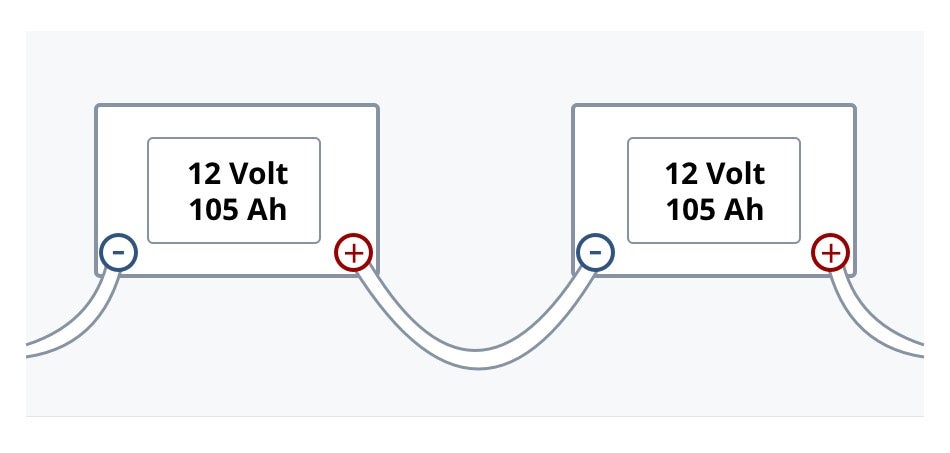There’s more to know about batteries than most people think. A large battery is really a collection of batteries in a casing. The battery stores power and supplies it. There are different types available, for example batteries for starting a vehicle or machine, for constant power or to support electrical installations. In this article you’ll learn more about batteries in general, how to increase the voltage or capacity of the battery, the state of charge of batteries in storage and what to do in case of battery problems.
What types of batteries are there?
There are a total of three different types of batteries. The difference between these three types lies in the structure of the batteries. Because of this they all have a different function.
● The starter battery
The starter battery gives a lot of power once. This can also be seen as short-lived power. The starter battery can be discharged up to 50%. In general, this is also the most commonly used type of battery. However, it is important to know that this battery is not suitable for propulsion.
There are also start/stop batteries. These also give a lot of power and are suitable for vehicles (typically newer cars) with a start-stop system
● The semi-traction battery
The semi-traction battery is a battery with a dual purpose. This battery can start a vehicle or machine as well as drive an electric machine.
● The traction battery
This battery is only suitable for propulsion. The traction battery delivers the current very slowly and can be discharged up to 80%.
Explore Kramp’s full range of starter, semi-traction and traction batteries here.
What and how can I use a battery?
Different batteries are intended for varying applications, such as vehicles, machines, and stationary setups such as generators. It is important to first think carefully about what the battery is needed for. Is this for a machine with built-in refrigerator, GPS and camera system? Or is it just for starting the engine?
Originally the battery was made to start an engine, but nowadays the battery has to be able to do more and more, including offering a lot of electrical support. Modern electrical connections and functions in vehicles are also called hoteling functions, with uses including powering a refrigerator, a GPS system or a beacon.
How do I increase the voltage or capacity of my battery?
It is possible to use two batteries if you need more capacity or voltage, creating what is called a series or parallel circuit. Below you can read more about these two different possibilities.
● Series set-up: Do you need more voltage? This set-up below involves positioning two equal batteries next to each other. The positive (+) terminal of one battery is connected to the negative (-) terminal of the other battery and thus creates 24V instead of 12V. The capacity (Ah) remains the same. In the illustration below, this remains 105 Ah.
 A series set-up
A series set-up● Parallel set-up: Do you need more capacity (Ah)? Here you connect the + of one battery to the + of the other battery and negative to negative. In the parallel battery arrangement, the voltage remains 12V, but the capacity is doubled. The parallel set-up in the picture below offers 210 Ah.
 A parallel set-up
A parallel set-upStorage and maintenance
Measuring is knowing!
If a battery is kept in storage, it is important that its voltage is measured and checked with a battery tester every three months. A full battery can be stored for longer and therefore has a longer lifespan. The advice is to always store the charge state above 12.5V. If the result is below 12.5V, then the battery needs to be charged. The table below shows what to do with batteries in which situation.
 Charge status of batteries in storage
Charge status of batteries in storageWhat to do in case of battery problems?
Of course there can always be problems, but it isn’t always the battery itself that’s at fault. Sometimes the wrong battery has been chosen, or there’s a problem in the power circuit. Does it look as though your battery is defective? Check the following points before you start searching for a replacement battery:
- Type / use*
- Voltage (V)
- Capacity (Ah)
- Poles, fixing and cabling
- Check alternator charging current
- Measure the power consumption of the starter motor
* Are there multiple power users on the vehicle? Then the question is whether a standard starter battery still is the right type. See also What and how can I use a battery earlier in this article.
Still experiencing problems after checking these points? Then your initial instinct that the battery is faulty is probably correct. Often, battery malfunction or failure is the result of poor maintenance. So, it is very important to maintain batteries properly, protect them against high temperatures and charge them on time. By properly maintaining a battery, it can last up to six years or more!
It’s worth knowing that new batteries must first be put into use before they will deliver their specified values; testing a new battery often gives incorrect values. You can learn more about selecting the correct standard in the battery tester and about batteries in the Battery Essentials Training with Kramp and Varta.
Charging the battery
For a modern battery you need a modern digital charger. If you don’t have this essential tool for continuous working already, take a look at our range of digital chargers.
In addition to self-testing the state of charge with a voltmeter, it is also possible to measure whether or not the capacity of the battery is sufficient. This is done with a digital battery tester. The number of volts may be sufficient, but if the capacity is not, the battery cannot provide the required power.
Remember to recycle
All old and used batteries can be recycled. Disposing of your dead or faulty batteries responsibly is extremely important. Many garages, scrap metal merchants and household waste recycling centres provide collection points. Check your local authority website for guidance on battery recycling in your area.
Do you have any questions about battery use, measuring, or finding the right battery? Feel free to contact our product specialists, email us via knowledgecenter@kramp.com or take a look at the batteries in our webshop.

